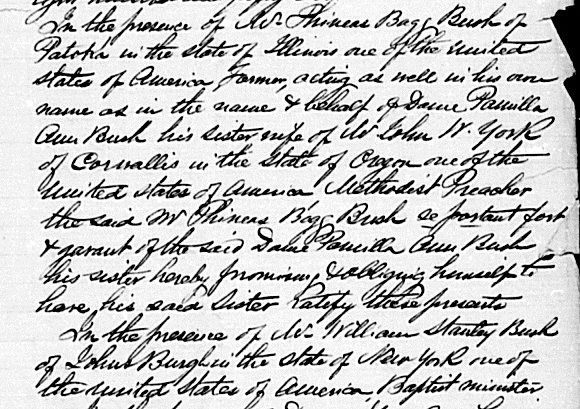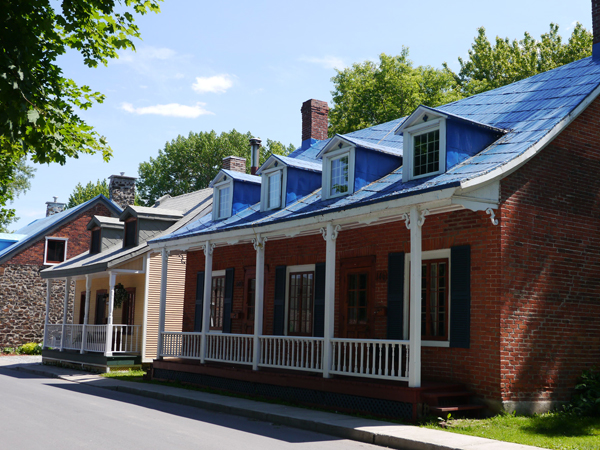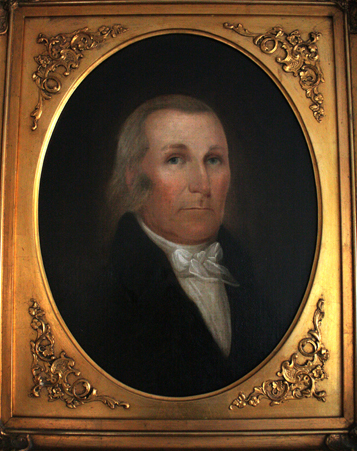When Sophia Bagg (c 1791-1860) left bequests in her will1to the children of her sister Polly, she also left a legacy to me. Thanks to Sophia’s will and the 1861 inventory of her possessions made following her death2, I have been able to trace the lives of Polly and her family.
Sophia, Polly, Stanley and Abner Bagg were the children of Phineas Bagg and Pamela Stanley of Pittsfield, Massachusetts, my four-times great-grandparents through Stanley. In this post I’m going to look at Polly, the eldest, and her children and grandchildren.

Polly Bagg was born in Connecticut on April 22, 1785.3 She married Massachusetts-born William Bush and they settled in West Haven, Vermont, not far from the southern tip of Lake Champlain. Perhaps Polly and William Bush had difficulty making ends meet in the early years of their marriage. A letter written in August 1824 by her brother Abner indicated that he was sending Polly a barrel of wool, “a present to a poor unfortunate sister.” 4
She also appears to have had help from her brother Stanley. He owned a share of the Bush family farm in Vermont and he left his share to Polly in his 1851 will. He died in 1853, but by that time the Bush family appears to have moved to the Midwest. According to the 1850 U.S. census, Phineas Bush, farmer, 28, was living with Mary Bush, 52 (Polly is a nickname for Mary) and William Bush, 53, farmer, in Clinton County, Illinois.
A photo posted on www.findagrave.com of Polly’s gravestone in Harrison Cemetery, Marion County, a rural area of southern Illinois, shows that she died there on Jan 9, 1856. Son Phineas is buried nearby, but I have not yet found a record of William Bush’s death. Polly’s and William’s four children were Pamelia Ann, Mary Sophia, William Stanley and Phineas Bagg.5
The two Bush daughters led very different lives, with Mary Sophia living in Quebec as a French-speaking Catholic and Pamelia Ann settling in Oregon. Neither was able to attend the 1861 inventory of their aunt’s will: Mary Sophia was already dead, and Pamelia lived too far away. Phineas Bagg Bush represented Pamelia at this family gathering. Sophia had left her 200 pounds, about $5,400 U.S. in today’s currency.
Sophia and her husband, Montreal-area landowner Gabriel Roy,6 adopted Polly’s daughter Mary Sophia Bush (c. 1815-1841) and brought her up in their St. Laurent home. In 1835, Mary Sophia Roy Bush married Louis Charles Lambert Dumont (1806-1841), the seigneur of Milles-Îles. He was the owner of a vast territory of forests, mountains, rivers and farms in what was basically a feudal system of land ownership in Quebec prior to 1854.
Both Mary Sophia and her husband died suddenly, on separate dates, in 1841. Their only child, Marguerite Virginie Lambert Dumont (1838-1874), who was just three years old at the time, became heir to the seigneurie. She was brought up by a notary in the town of Saint-Eustache, north of Montreal. When she was 15, she married her cousin, Charles Auguste Maximilien (CAM) Globensky (1830-1906). Virginie had eight children and died at age 36.
Polly’s other daughter, Pamelia Ann (1812-1880),7had a much longer life, but no children. The inventory of Sophia’s will identified her as the wife of John W. York, a Methodist Episcopal minister in Oregon.
The 1840 U.S. Federal Census showed that Pamelia was no longer living in Vermont with her parents at that time. The Early Oregonian8 indicates that Pamelia had a first husband, George Quinton, but I have so far been unable to find a marriage record, place of residence or his date of death.
In 1847, she married clergyman John W. York in Marion, Illinois. Born in Georgia in 1801, John W. York had previously lived in Missouri and he had been married twice before.9 According to the 1850 census, he had three teenage daughters.10
In 1852, Pamelia and John moved to Oregon, settling in Corvallis, Benton County. Corvallis was located on busy transportation route and was a growing town.11 John was admitted to the Oregon Conference and worked as a Methodist Episcopal minister there for many years, travelling the area circuits and overseeing the construction of a new church.
In the 1880 census, Pamelia was listed as an invalid and she died that December. John died in 1884. Both are buried in Mount Union Cemetery, Philomath, Benton County, Oregon.12
As for son Phineas (1820-1867), I have not completed my research on him and his family, but according to www.findagrave.com, he died in Marion County, Illinois on Jan. 4, 1867. His widow, Louise M. Bush, was listed in a city directory in Chattanooga, Tennessee in 1905.
Three young daughters are buried in the same Illinois graveyard as Phineas, but two other daughters appear to have accompanied the widowed Louise to Tennessee. I have written about son William Stanley Bush (c. 1816-1892) in a separate article. (This article was revised Oct. 2, 2016)
See also:
Janice Hamilton, “William S. Bush, Baptist Preacher,” Writing Up the Ancestors, May 19, 2016 https://www.writinguptheancestors.ca/2016/05/william-s-bush-baptist-preacher.html
Janice Hamilton, “Polly Bagg Bush: A Surprise Sister,” Writing Up the Ancestors, May 23, 2014 https://www.writinguptheancestors.ca/2014/05/polly-bagg-bush-surprise-sister.html
Janice Hamilton, “The Doomed Marriage of Mary Sophia Roy Bush and Louis Charles Lambert Dumont,” Writing Up the Ancestors, Jan. 27, 2015, https://www.writinguptheancestors.ca/2015/01/sophia-mary-roy-bush-and-louis-charles.html
Janice Hamilton, “Marguerite Virginie Globensky,” Writing Up the Ancestors, Jan. 27, 2015, https://www.writinguptheancestors.ca/2015/01/the-story-of-marguerite-virginie.html
Notes and Footnotes
- Notary J.A. Labadie, 18 mai, 1856, #14278, Bibliothèque et Archives nationales du Québec
- Notary Leo Labadie, 28 January, 1861, #6248, Bibliothèque et Archives nationales du Québec
- I previously believed that Polly (Mary was her real name) was born in Pittsfield, MA, however, Pamelia told the census-takers in 1880 that her mother was born in Connecticut. This makes sense because Polly’s mother, Pamela Stanley, was from Litchfield, CT, and the two towns are not far apart. I have not found any record of Polly’s birth or marriage, only census records and a photo of her gravestone. Her date of birth is calculated from age at death, as recorded on her gravestone.
- This letter is in Abner Bagg’s letterbook, PO70/B1, the Bagg Family Fonds, held at the McCord Museum in Montreal.
- Searches on www.ancestry.ca for William Bush in the 1820, 1830 and 1840 United States Federal Census show the family living in West Haven, Rutland, Vermont. In 1830, there were only five people in this household rather than the expected two adults and four children; Mary Sophia had already gone to live with her aunt in Lower Canada.
- I have yet to find photographs or portraits of any of these individuals except for Virginie. Sophia and Gabriel Roy must have had their portraits done, so if you come across images of any of these people, please contact me at janhamilton66@gmail.com.
- Pamelia appears in records and censuses as Pamelia Ann Bush (most likely her correct name at birth), Amelia Bush, Permilia Duinton, Pamelia Ann Bush York, Parmelia York, P.A. York and Pamelia A. York. In her will, Sophia referred to her as Ann, so perhaps that is the name she usually used.
- Oregon Secretary of State, “Pamelia Ann Bush,” Early Oregonian Search, https://secure.sos.state.or.us/prs/profile.do?ancRecordNumber=100338, accessed April 23, 2016.
- “Oregon Conference,” Minutes of the Annual Conferences of the Methodist Episcopal Church. Spring Conferences of 1884. New York: Phillips and Hunt, 1884, p. 334, https://googlebooks.ca, accessed April 24, 2013.
- The 1850 U.S. Federal Census on Ancestry.ca showed John W. York, 48, farmer, and Parmelia York, 38, living in District 68, Clinton, Illinois. With them were Martha York, 19, Ann York, 17, and Emily York, 15. Also with them were Nathan Dougherty, 22 and Andrew Carr, 20. I don’t know who these young men were, perhaps farm workers.
- For more information about the history of Corvallis, Oregon, see the website of the Benton County Historical Society, http://www.bentoncountymuseum.org/index.php/research/benton-county-history/
- Pamelia Ann Bush York, Find a Grave, http://www.findagrave.com/cgi-bin/fg.cgi?page=gr&GRid=25056543&ref=acom, accessed April 23 2016.


